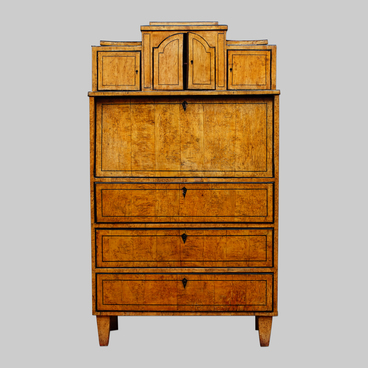DmItrovsky was the first private porcelain factory in Russia. The factory was founded by the Russified Englishman Francis Gardner in 1766.
The factory produced top quality porcelain, and the founder himself was awarded an audience with Empress Catherine II. However, the factory began to lose ground by the end of the century. In 1892, it was purchased by Matvey Kuznetsov and successfully integrated into his company M. S. Kuznetsov’s Partnership For Production of Porcelain and Dutchware Items. The factory was going through hard times at the time of purchase, so Kuznetsov easily reached an agreement with Elizaveta Gardner, who sold her business for 238,000 rubles, and all factory models, molds, drawings, and samples for another 500 rubles.
Thus, Matvey Kuznetsov became the owner of not only a new factory, but also a popular trademark with more than 100 years of history, rich traditions, qualified specialists, and proven technologies and know-hows. Kuznetsov saw the popularity of Gardner’s porcelain and, not wanting to lose customers, continued to put his famous stamp on the products. He also tried to preserve the range and general appearance of the original products.
Having studied the market, Kuznetsov chose to produce mainly tea and dining sets, as well as individual items under Gardner’s old designs. He manufactured icon lamps, candles, chandeliers, and cups for churches. For the 100th anniversary of the Battle of Borodino, he released plates, cups, bread baskets, dishes, and vases depicting episodes from the Patriotic War of 1812. The factory also made souvenirs and gifts for various holidays and events.
Some produces were decorated with inscriptions inspired by various proverbs, adages, and
congratulatory texts. The exhibit on display has an inscription under its rim saying “Charochka (a vessel for strong alcohol) traveled around the table.” This is probably a phrase from a folk song, which can be found in the 1788 Songbook. The porcelain mug has an elegant shape and is decorated with a three-dimensional ornament. It has a pink coating with golden decorative lines.
The blue symbol on the bottom of the mug depicts a double-headed eagle, the words “M.S. Kuznetsov Partnership, ” and the letters D and F, which stand for Dmitrovsky Factory.
The factory was officially renamed Dmitrovsky Porcelain Factory after the 1917 revolution.
The factory produced top quality porcelain, and the founder himself was awarded an audience with Empress Catherine II. However, the factory began to lose ground by the end of the century. In 1892, it was purchased by Matvey Kuznetsov and successfully integrated into his company M. S. Kuznetsov’s Partnership For Production of Porcelain and Dutchware Items. The factory was going through hard times at the time of purchase, so Kuznetsov easily reached an agreement with Elizaveta Gardner, who sold her business for 238,000 rubles, and all factory models, molds, drawings, and samples for another 500 rubles.
Thus, Matvey Kuznetsov became the owner of not only a new factory, but also a popular trademark with more than 100 years of history, rich traditions, qualified specialists, and proven technologies and know-hows. Kuznetsov saw the popularity of Gardner’s porcelain and, not wanting to lose customers, continued to put his famous stamp on the products. He also tried to preserve the range and general appearance of the original products.
Having studied the market, Kuznetsov chose to produce mainly tea and dining sets, as well as individual items under Gardner’s old designs. He manufactured icon lamps, candles, chandeliers, and cups for churches. For the 100th anniversary of the Battle of Borodino, he released plates, cups, bread baskets, dishes, and vases depicting episodes from the Patriotic War of 1812. The factory also made souvenirs and gifts for various holidays and events.
Some produces were decorated with inscriptions inspired by various proverbs, adages, and
congratulatory texts. The exhibit on display has an inscription under its rim saying “Charochka (a vessel for strong alcohol) traveled around the table.” This is probably a phrase from a folk song, which can be found in the 1788 Songbook. The porcelain mug has an elegant shape and is decorated with a three-dimensional ornament. It has a pink coating with golden decorative lines.
The blue symbol on the bottom of the mug depicts a double-headed eagle, the words “M.S. Kuznetsov Partnership, ” and the letters D and F, which stand for Dmitrovsky Factory.
The factory was officially renamed Dmitrovsky Porcelain Factory after the 1917 revolution.

